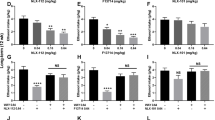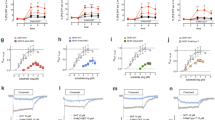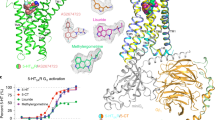Abstract
The anatomical distribution and pharmacology of serotonin 6 receptors (5-HT6Rs) implicate them as contributors to the serotonergic regulation of complex behavior. To complement the limited range of pharmacological tools available to examine 5-HT6R function, we have generated a mouse line bearing a constitutive null mutation of the 5-HT6R gene. No perturbations of baseline behavior were noted in a wide array of assays pertinent to multiple neurobehavioral processes. However, 5-HT6R mutant mice demonstrated reduced responses to the ataxic and sedative effects of ethanol. No differences in ethanol metabolism were evident between wild-type and 5-HT6R mutant mice. These findings implicate 5-HT6Rs in the serotonergic modulation of responses to ethanol.
Similar content being viewed by others
Log in or create a free account to read this content
Gain free access to this article, as well as selected content from this journal and more on nature.com
or
References
Aghajanian GK, Sanders-Bush E (2002). Serotonin. In: Davis KL, Charney D, Coyle J, Nemeroff C (eds). Neuropsychopharmacology: The Fifth Generation of Progress. American College of Neuropsychopharmacology: Nashville, TN. pp 15–34.
Barnes NM, Sharp T (1999). A review of central 5-HT receptors and their function. Neuropharmacology 38: 1083–1152.
Belknap JK, Crabbe JC, Young ER (1993). Voluntary consumption of ethanol in 15 inbred mouse strains. Psychopharmacology (Berl) 112: 503–510.
Bentley JC, Bourson A, Boess FG, Fone KC, Marsden CA, Petit N et al (1999). Investigation of stretching behaviour induced by the selective 5-HT6 receptor antagonist, Ro 04-6790, in rats. Br J Pharmacol 126: 1537–1542.
Blakley GG, Pohorecky LA, Benjamin D (2001). Bidirectional changes in ethanol consumption in rats with site-specific antisense down-regulation of 5-hydroxytryptamine2A receptors in brain. J Pharmacol Exp Ther 299: 277–289.
Boess FG, Riemer C, Bos M, Bentley J, Bourson A, Sleight AJ (1998). The 5-HT6 receptor selective radioligand [3H] Ro 63-0563 labels 5-hydroxytryptamine receptor binding sites in rat and porcine striatum. Mol Pharmacol 54: 577–583.
Bos M, Sleight AJ, Godel T, Martin JR, Riemer C, Stadler H (2001). 5-HT(6) receptor antagonists: lead optimisation and biological evaluation of N-aryl and N-heteroaryl 4-amino-benzene sulfonamides. Eur J Med Chem 36: 165–178.
Bourson A, Borroni E, Austin RH, Monsma Jr FJ, Sleight AJ (1995). Determination of the role of the 5-HT6 receptor in the rat brain: a study using antisense oligonucleotides. J Pharmacol Exp Ther 274: 173–180.
Bouwknecht JA, Hijzen TH, van der Gugten J, Maes RA, Hen R, Olivier B (2000). Ethanol intake is not elevated in male 5-HT(1B) receptor knockout mice. Eur J Pharmacol 403: 95–98.
Branchek TA, Blackburn TP (2000). 5-HT6 receptors as emerging tar-gets for drug discovery. Annu Rev Pharmacol Toxicol 40: 319–334.
Crabbe JC, Johnson NA, Gray DK, Kosobud A, Young ER (1982). Biphasic effects of ethanol on open-field activity: sensitivity and tolerance in C57BL/6N and DBA/2N mice. J Comp Physiol Psychol 96: 440–451.
Crabbe JC, Phillips TJ, Feller DJ, Hen R, Wenger CD, Lessov CN et al (1996). Elevated alcohol consumption in null mutant mice lacking 5-HT1B serotonin receptors. Nat Genet 14: 98–101.
Cunningham CL, Fidler TL, Hill KG (2000). Animal models of alcohol's motivational effects. Alcohol Res Health 24: 85–92.
Engel SR, Allan AM (1999). 5-HT3 receptor over-expression enhances ethanol sensitivity in mice. Psychopharmacology (Berl) 144: 411–415.
Engel SR, Lyons CR, Allan AM (1998). 5-HT3 receptor over-expression decreases ethanol self administration in transgenic mice. Psychopharmacology (Berl) 140: 243–248.
Frantz KJ, Hansson KJ, Stouffer DG, Parsons LH (2002). 5-HT6 receptor antagonism potentiates the behavioral & neurochemical effects of amphetamine but not cocaine. Neuropharmacology 44: 170–180.
Gardell LR, Whalen CA, Chattophadyay S, Cavallaro CA, Hubbell CL, Reid LD (1997). Combination of naltrexone and fluoxetine on rats' propensity to take alcoholic beverage. Alcohol Clin Exp Res 21: 1435–1439.
Gérard C, Martres M-P, Lefèvre K, Miquel MC, Vergé D, Lanfumey L et al (1997). Immuno-localization of serotonin 5-HT6 receptor-like material in the rat central nervous system. Brain Res 746: 207–219.
Gill K, France C, Amit Z (1986). Voluntary ethanol consumption in rats: an examination of blood/brain ethanol levels and behavior. Alcohol Clin Exp Res 10: 457–462.
Glatt CE, Snowman AM, Sibley DR, Snyder SH (1995). Clozapine: selective labeling of sites resembling 5HT6 serotonin receptors may reflect psychoactive profile. Mol Med 1: 398–406.
Gongwer MA, Murphy JM, McBride WJ, Lumeng L, Li TK (1989). Regional brain contents of serotonin, dopamine and their metabolites in the selectively bred high- and low-alcohol drinking lines of rats. Alcohol 6: 317–320.
Gorwood P, Aissi F, Batel P, Ades J, Cohen-Salmon C, Hamon M et al (2002). Reappraisal of the serotonin 5-HT(1B) receptor gene in alcoholism: of mice and men. Brain Res Bull 57: 103–107.
Gulley JM, McNamara C, Barbera TJ, Ritz MC, George FR (1995). Selective serotonin reuptake inhibitors: effects of chronic treatment on ethanol-reinforced behavior in mice. Alcohol 12: 177–181.
Hallikainen T, Saito T, Lachman HM, Volavka J, Pohjalainen T, Ryynanen OP et al (1999). Association between low activity serotonin transporter promoter genotype and early onset alcoholism with habitual impulsive violent behavior. Mol Psychiatry 4: 385–388.
Hamon M, Doucet E, Lefevre K, Miquel MC, Lanfumey L, Insausti R et al (1999). Antibodies and antisense oligonucleotide for probing the distribution and putative functions of central 5-HT6 receptors. Neuropsychopharmacology 21: 68S–76S.
Hatcher PD, Brown VJ, Tait DS, Bate S, Overend P, Hagan JJ et al (2005). 5-HT6R antagonists improve performance in an attentional set shifting task in rats. Psychopharmacol 181: 253–259.
Heisler LK, Chu H-M, Brennan TJ, Danao JA, Bajwa P, Parsons LH et al (1998). Elevated anxiety and antidepressant-like responses in serotonin 5-HT1A receptor mutant mice. Proc Natl Acad Sci USA 95: 15049–15054.
Higley JD, Linnoila M (1997). A nonhuman primate model of excessive alcohol intake: personality and neurobiological parallels of type I- and type II-like alcoholism. In: Galanter M (ed). Recent Developments in Alcoholism, Vol 1. Plenum Press: New York. pp 191–219.
Hirst WD, Abrahamsen B, Blaney FE, Calver AR, Aloj L, Price GW et al (2003). Differences in the central nervous system distribution and pharmacology of the mouse 5-hydroxytryptamine-6 receptor compared with rat and human receptors investigated by radioligand binding, site-directed mutagenesis, and molecular modeling. Mol Pharmacol 64: 1295–1308.
Hoyer D, Clarke DE, Fozard JR, Hartig PR, Martin GR, Mylecharane EJ et al (1994). International Union of Pharmacology classification of receptors for 5-hydroxytryptamine (serotonin). Pharmacol Rev 46: 157–203.
Kohen R, Metcalf MA, Khan N, Druck T, Huebner K, Lachowicz JE et al (1996). Cloning, characterization, and chromosomal localization of a human 5-HT6 serotonin receptor. J Neurochem 66: 47–56.
Lamb RJ, Jarbe TU (2001). Effects of fluvoxamine on ethanol-reinforced behavior in the rat. J Pharmacol Exp Ther 297: 1001–1009.
Lane H-Y, Lin C-C, Huang C-H, Chang Y-C, Hsu S-K, Chang W-H (2004). Risperidone response and 5-HT6 receptor gene variance; genetic association analysis with adjustment for nongenetic confounders. Schizophr Res 67: 63–70.
Lindner MD, Hodges Jr DB, Hogan JB, Orie AF, Corsa JA, Barten DM et al (2003). An assessment of the effects of serotonin 6 (5-HT6) receptor antagonists in rodent models of learning. J Pharmacol Exp Ther 307: 682–691.
Lucas LA, McMillen BA (2002). Differences in brain area concentrations of dopamine and serotonin in Myers' High Ethanol Preferring (mHEP) and outbred rats. J Neural Transm 109: 279–292.
Mansour SL, Thomas KR, Capecchi MR (1988). Disruption of the proto-oncogene int-2 in mouse embryo-derived stem cells: a general strategy for targeting mutations to non-selectable genes. Nature 336: 348–352.
Maurel S, De Vry J, De Beun R, Schreiber R (1999). 5-HT2A and 5-HT2C/5-HT1B receptors are differentially involved in alcohol preference and consummatory behavior in cAA rats. Pharmacol Biochem Behav 62: 89–96.
Meneses A (2001). Role of 5-HT6 receptors in memory formation. Drug News Perspect 14: 396–400.
Mihalek RM, Bowers BJ, Wehner JM, Kralic JE, VanDoren MJ, Morrow AL et al (2001). GABAA-receptor δ subunit knockout mice have multiple defects in behavioral responses to ethanol. Alcohol Clin Exp Res 25: 1708–1718.
Monsma Jr FJ, Shen Y, Ward RP, Hamblin MW, Sibley DR (1993). Cloning and expression of a novel serotonin receptor with high affinity for tricyclic psychotropic drugs. Mol Pharmacol 43: 320–327.
Murphy JM, McBride WJ, Lumeng L, Li TK (1987). Contents of monoamines in forebrain regions of alcohol-preferring (P) and -nonpreferring (NP) lines of rats. Pharmacol Biochem Behav 26: 389–392.
Murphy JM, Stewart RB, Bell RL, Badia-Elder NE, Carr LG, McBride WJ et al (2002). Phenotypic and genotypic characterization of the Indiana University rat lines selectively bred for high and low alcohol preference. Behav Genet 32: 363–388.
Myers RD, Robinson DE, West MW, Biggs TA, McMillen BA (1998). Genetics of alcoholism: rapid development of a new high-ethanol-preferring (HEP) strain of female and male rats. Alcohol 16: 343–357.
Naranjo CA, Knoke DM (2001). The role of selective serotonin reuptake inhibitors in reducing alcohol consumption. J Clin Psychiatry 62(Suppl 20): 18–25.
Ohmori O, Shinkai T, Hori H, Nakamura J (2001). Novel polymorphism in the 5′-upstream region of the human 5-HT6 receptor gene and schizophrenia. Neurosci Lett 310: 17–20.
Otano A, Frechilla D, Cobreros A, Cruz-Orive LM, Insausti A, Insausti R et al (1999). Anxiogenic-like effects and reduced stereological counting of immunolabelled 5 hydroxytryptamine 6 receptors in rat nucleus accumbens by antisense oligonucleotides. Neuroscience 92: 1001–1009.
Pettinati HM (2001). The use of selective serotonin reuptake inhibitors in treating alcoholic subtypes. J Clin Psychiatry 62(Suppl 20): 26–31.
Phillips TJ, Hen R, Crabbe JC (1999). Complications associated with genetic background effects in research using knockout mice. Psychopharmacology (Berl) 147: 5–7.
Phillips TJ, Shen EH (1996). Neurochemical bases of locomotion and ethanol stimulant effects. Int Rev Neurobiol 39: 243–282.
Pistis M, Muntoni AL, Gessa G, Diana M (1997). Effects of acute, chronic ethanol and withdrawal on dorsal raphe neurons: electrophysiological studies. Neuroscience 79: 171–176.
Riemer C, Borroni E, Levet-Trafit B, Martin JR, Poli S, Porter RH et al (2003). Influence of the 5-HT6 receptor on acetylcholine release in the cortex: pharmacological characterization of 4-(2-bromo-6-pyrrolidin-1-ylpyridine-4-sulfonyl)phenylamine, a potent and selective 5-HT6 receptor antagonist. J Med Chem 46: 1273–1276.
Risinger FO (1997). Fluoxetine's effects on ethanol's rewarding, aversive and stimulus properties. Life Sci 61: PL235–PL242.
Risinger FO, Brown MM, Doan AM, Oakes RA (1998). Mouse strain differences in oral operant ethanol reinforcement under continuous access conditions. Alcohol Clin Exp Res 22: 677–684.
Risinger FO, Doan AM, Vickrey AC (1999). Oral operant ethanol self-administration in 5-HT1b knocokout mice. Behav Brain Res 102: 211–215.
Roberts AJ, Heyser CJ, Koob GF (1999). Operant self-administration of sweetened versus unsweetened ethanol: effects on blood alcohol levels. Alcohol Clin Exp Res 23: 1151–1157.
Roberts JC, Reavill C, East SZ, Harrison PJ, Patel S, Routledge C et al (2002). The distribution of 5-HT(6) receptors in rat brain: an autoradiographic binding study using the radiolabelled 5-HT(6) receptor antagonist [(125)I]SB-258585. Brain Res 934: 49–57.
Rodd-Henricks ZA, McKinzie DL, Melendez RI, Berry N, Murphy JM, McBride WJ (2003). Effects of serotonin-3 receptor antagonists on the intracranial self-administration of ethanol within the ventral tegmental area of Wistar rats. Psychopharmacology (Berl) 165: 252–259.
Rogers DC, Hagan JJ (2001). 5-HT6 receptor antagonists enhance retention of a water maze task in the rat. Psychopharmacology (Berl) 158: 114–119.
Roth BL, Craigo SC, Choudhary MS, Uluer A, Monsma Jr FJ, Shen Y et al (1994). Binding of typical and atypical antipsychotic agents to 5-hydroxytryptamine-6 and 5-hydroxytryptamine-7 receptors. J Pharmacol Exp Ther 268: 1403–1410.
Routledge C, Price GW, Bromidge SM, Moss SF, Newman G, Riley T et al (1999). Characterisation of SB-271046, a potent and selective 5-HT6 receptor antagonist. Br J Pharmacol 127: 21P.
Ruat M, Traiffort E, Arrang JM, Tardivel-Lacombe J, Diaz J, Leurs R et al (1993). A novel rat serotonin (5-HT6) receptor: molecular cloning, localization and stimulation of cAMP accumulation. Biochem Biophys Res Commun 193: 268–276.
Russell MG, Dias R (2002). Memories are made of this (perhaps): a review of serotonin 5-HT(6) receptor ligands and their biological functions. Curr Top Med Chem 2: 643–654.
Sambrook J, Fritsch EF, Maniatis T (2001). Molecular Cloning, A Laboratory Manual, 3rd edn. Cold Spring Harbor Laboratory: Cold Spring Harbor, NY.
Samson HH, Pfeiffer AO, Tolliver GA (1998). Oral ethanol self-administration in rats: models of alcohol-seeking behavior. Alcohol Clin Exp Res 12: 591–598.
Shinkai T, Ohmori O, Kojima H, Terao T, Suzuki T, Abe K (1999). Association study of the 5-HT6 receptor gene in schizophrenia. Am J Med Genet (Neuropsych Genet) 88: 120–122.
Sleight AJ, Boess FG, Bos M, Levet-Trafit B, Riemer C, Bourson A (1998). Characterization of Ro 04-6790 and Ro 63-0563: potent and selective antagonists at human and rat 5-HT6 receptors. Br J Pharmacol 124: 556–562.
Sleight AJ, Monsma Jr FJ, Borroni E, Austin RH, Bourson A (1996). Effects of altered 5-ht6 expression in the rat: functional studies using antisense oligonucleotides. Behav Brain Res 73: 245–248.
Stean TO, Hirst WD, Thomas DR, Price GW, Rogers D, Riley G et al (2002). Pharmacological profile of SB-357134: a potent, selective, brain penetrant, and orally active 5-HT(6) receptor antagonist. Pharmacol Biochem Behav 71: 645–654.
Svartengren J, Axelsson-Lendin P, Edling N, Fhölenhag K, Isacson R, Hillegaart V et al (2004). The Selective Serotonin 5-HT6 Receptor Antagonist BVT5182 Decreases Food Intake and Body Weight in Both Rats and Mice. Abstract/Viewer/Itinerary Planner. Society for Neuroscience: Washington, DC. Online.
Thiele TE, Miura GI, Marsh DJ, Bernstein IL, Palmiter RD (2000). Neurobiological responses to ethanol in mutant mice lacking neuropeptide Y or the Y5 receptor. Pharmacol Biochem Behav 67: 683–691.
Thome J, Retz W, Baader M, Pesold B, Hu M, Cowen M et al (2001). Association analysis of HTR 6 and HTR 2A polymorphisms in sporadic Alzheimer's disease. J Neural Transm 108: 1175–1180.
Tomkins DM, Joharchi N, Tampakeras M, Martin JR, Wichmann J, Higgins GA (2002). An investigation of the role of 5-HT(2C) receptors in modifying ethanol self-administration behaviour. Pharmacol Biochem Behav 71: 735–744.
Tsai S-J, Chiu H-J, Want Y-C, Hong C-J (1999a). Association study of serotonin-6 receptor variant (C267T) with schizophrenia and aggressive behavior. Neurosci Lett 271: 135–137.
Tsai S-J, Liu H-C, Liu T-Y, Want Y-C, Hong C-J (1999b). Association analysis of the 5-HT6 receptor polymorphism C267T in Alzheimer's disease. Neurosci Lett 267: 139.
Unsworth CD, Molinoff PB (1994). Characterization of a 5-hydroxytryptamine receptor in mouse neuroblastoma N18TG2 cells. J Pharmacol Exp Ther 269: 246–255.
Virkkunen M, Linnoila M (1996). Serotonin and glucose metabolism in impulsively violent alcoholic offenders. In: Stoff DM, Cairns RB (eds). Aggression and Violence: Genetic, Neurobiological, and Biosocial Perspectives. Lawrence Erlbaum: Mahwah, NJ. pp 87–100.
Ward RP, Hamblin MW, Lachowicz JE, Hoffman BJ, Sibley DR, Dorsa DM (1995). Localization of serotonin subtype 6 receptor messenger RNA in the rat brain by in situ hybridization histochemistry. Neuroscience 64: 1105–1111.
Weiss F, Porrino LJ (2002). Behavioral neurobiology of alcohol addiction: recent advances and challenges. J Neurosci 22: 3332–3337.
West MW, Kalmus G, Myers RD (1998). Limited access to ethanol in genetic drinking rats is suppressed while feeding is enhanced by the mixed 5-HT1A agonist/5-HT2A antagonist FG5938. Pharmacol Biochem Behav 60: 823–828.
Wilson AW, Costall B, Neill JC (2000). Manipulation of operant responding for an ethanol-paired conditioned stimulus in the rat by pharmacological alteration of the serotonergic system. J Psychopharmacol 14: 340–346.
Woolley ML, Bentley JC, Sleight AJ, Marsden CA, Fone KC (2001). A role for 5-ht6 receptors in retention of spatial learning in the Morris water maze. Neuropharmacology 41: 210–219.
Woolley ML, Marsden CA, Fone KCF (2004). 5-ht6 receptors. Curr Drug Targets—CNS Neurol Disorders 3: 59–79.
Yan QS (1999). Extracellular dopamine and serotonin after ethanol monitored with 5-minute microdialysis. Alcohol 19: 1–7.
Yoshimoto K, McBride WJ, Lumeng L, Li TK (1992). Alcohol stimulates the release of dopamine and serotonin in the nucleus accumbens. Alcohol 9: 17–22.
Yoshioka M, Matsumoto M, Togashi H, Mori K, Saito H (1998). Central distribution and function of 5-HT6 receptor subtype in the rat brain. Life Sciences 62: 1473–1477.
Zhou FC, Bledsoe S, Lumeng L, Li TK (1991). Immunostained serotonergic fibers are decreased in selected brain regions of alcohol-preferring rats. Alcohol 8: 425–431.
Zhou FC, Pu CF, Murphy J, Lumeng L, Li TK (1994). Serotonergic neurons in the alcohol preferring rats. Alcohol 11: 397–403.
Acknowledgements
This research was funded in part by grants from the American Federation for Aging Research (SJB), Department of Veteran's Affairs (HMC), National Alliance for Research on Schizophrenia and Depression (HMC), and Program for Minority Research Training in Psychiatry 5T32MH19126 (HMC). We thank Drs Mark Hamblin and Ruth Kohen for a 5-HT6 receptor genomic fragment, Dr Roger Pederson for 129-derived embryonic stem cells, and Dr Warren Hirst for use of 125I-SB258585. We also thank Jean Danao, Irene Yun, Aileen Sweeney, and Jed Holtzman for their technical skills and support.
Author information
Authors and Affiliations
Corresponding author
Additional information
Supplementary information accompanies the paper on Neuropsychopharmacology website (http://www.nature.com/npp)
Rights and permissions
About this article
Cite this article
Bonasera, S., Chu, HM., Brennan, T. et al. A Null Mutation of the Serotonin 6 Receptor Alters Acute Responses to Ethanol. Neuropsychopharmacol 31, 1801–1813 (2006). https://doi.org/10.1038/sj.npp.1301030
Received:
Revised:
Accepted:
Published:
Issue date:
DOI: https://doi.org/10.1038/sj.npp.1301030
Keywords
This article is cited by
-
Acute EPA-induced learning and memory impairment in mice is prevented by DHA
Nature Communications (2020)
-
GPCR and Alcohol-Related Behaviors in Genetically Modified Mice
Neurotherapeutics (2020)
-
The 5-HT6 receptor agonist EMD 386088 produces antidepressant and anxiolytic effects in rats after intrahippocampal administration
Psychopharmacology (2011)
-
Excess of serotonin affects embryonic interneuron migration through activation of the serotonin receptor 6
Molecular Psychiatry (2009)
-
Pro-cognitive effects of 5-HT6 receptor antagonists in the social recognition procedure in rats: implication of the frontal cortex
Psychopharmacology (2008)



